40 pond water lab worksheet
PDF Pond Water Webs Answer Sheet - Crystal Clear Education Pond Water Webs: Worksheet Answers 1. Producers = phytoplankton, seaweed 2. Carnivore = fish, gull, lobster, prawn, crab, whelk Omnivore = mussels Herbivore = zooplankton, limpets 3. (a) We would expect the limpet population to decrease since the organisms that eat mussels would have to eat more limpets. (b) We would expect the zooplankton population to increase, since the increased fish ... Vritual Pond Dip - The Biology Corner Instructions: A jar shows several organisms that might be found in pond water. When you click on one of the organisms, a page opens with more information. If you scroll over the organisms in the jar, you can see their names. -Use the back buttons to return to the page with the jar.
Pond Water Lab | Teaching Resources Students investigate pond water organisms under the microscope and answer follow-up questions.
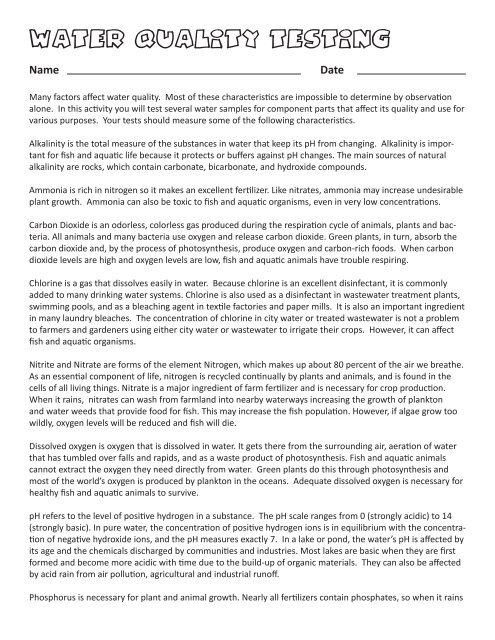
Pond water lab worksheet
DOC Title: Pond Water Lab - kenanfellows.org 1. Collect a few drops of water from the bottom of your water sample using an eye dropper. 2. Place a drop on the center of the microscope slide. 3. Cover the slide with a cover slip by lowering the cover slip at an angle over the water drop in a manner that spreads out the water drop, but does not trap air bubbles. 4. PDF Eutrophication Worksheet - Cary Institute 1. Obtain three mason jars (or other containers), pond water, a graduated cylinder, a microscope, slides, and a pipette. 2. Fill each jar (these jars are your mini-ecosystems) about halfway with the pond water (in a normal sized mason jar, this would be about 500-700 mL of water). Make sure you add the same amount of water to each jar. PDF Teacher Notes - Science Spot Provide copies of the lab worksheet to allow students to document their observations. ... found in the pond water samples to determine which organisms were most abundant. Use the data to create graphs or charts to compare the population of several of the species. 5. If you have access to a computer microscope or camera, allow time for students ...
Pond water lab worksheet. PDF Pond Life: Macro & Microscopic Views Teacher Guide Computer access (laptop computer for each lab group if available) Procedure: Part One: Pond water examination (30 minutes) Students examine water samples under a lower magnification (Stereo or macro-view), in search of any living organisms. After observing the water, students answer questions 1 & 2 on the lab activity sheet. Students then ... Pond Water Lab Worksheet - Sixteenth Streets Nov 08, 2021 · Pond Water Lab Worksheet. Using the virtual pond dip, you will analyze a sample from a fresh water pond. However, before you get a water sample, you should observe the water in the Pond Water Lab Worksheet Escolagersonalvesgui from escolagersonalvesgui.blogspot.com Students can investigate the ecosystems and behaviors within a drop of water. Pond Water Lab Teaching Resources | Teachers Pay Teachers Laboratory, Printables, Worksheets Pond Water Lab: Observing an Ecosystem (for Ecology) by Chem Queen 1 $1.49 Word Document File This simple lab gives students an opportunity to measure abiotic factors (temperature, pH, and dissolved oxygen) and biotic factors (microorganisms) of pond water. Just stop by a local pond and get a pail of pond water. Activity: Determining Water Quality | Teaching Great Lakes ... Exploring water quality worksheet; Procedure Advance Preparation. Create water quality jars. Fill the five jars with water. (Jar 5 will be filled with the river water.) Jar 1 - Add enough coffee grounds and cocoa powder until the water has a good "dirty" look. Label it jar 1. Jar 2 - Add food coloring so that the water appears clear purple.
Ward's® Investigating Pond Life Lab Activity | Ward's Science Don't worry about taking field samples of pond water; our ready-to-use sample contains a variety of pond-dwelling organisms that are visible to the eye. Ordering information: Set includes Daphnia, hornwort, duckweed, snails, Hydra, Planaria , and a host of freshwater protists in a 32 oz. water sample. PDF Lesson Plan: Yucky Water! A Water Quality Lab Investigation • Water samples (tap, stream, and polluted, see Teacher Notes at end of lesson). Time Needed: • Assign pre-lab homework 2 days before lab • 15 minutes to review pre-lab homework and to introduce activity day before lab • 60-minute class period for lab activity • 15 minutes for post-activity class discussion the day after lab Pond Water Under the Microscope Pond Water Under the Microscope. Pond water refers to a standing body of water. This is usually smaller than a lake and may either be man-made or natural. Pond water contains a variety of plant and animal life. While some can be seen with the naked eye, others are too small and will require the use of a microscope to be able to properly observe ... PDF Pond Water Lab: Biodiversity of Ponds - Mr. Rott's Science ... lab, you will examine a sample of pond water you collect to identify different microscopic organisms. The following resources (also on the class website) will serve as your guide to correctly identifying the organisms you observe. Be sure to label and count number of species, identify the power for
Pond Dip - Bring an Ecosystem into the Classroom pond water - this might be the one supply that keeps teachers from doing this lab. Micro-rich water is not too hard to find in most places - any relatively natural fresh water source will do, such as ponds, streams and lakes. Artificial ponds such as a Koi ponds work too. Even well-established fish tanks have a micro-community within them! PDF Pond Water Observation Lab - Boston University Slide Coverslip Glycerin Microscope Water sample Get a drop of glycerin on your slide. Ask a teacher for a pond water sample. CAREFULLY lower the coverslip onto the slide—you don't want to crush any of the organisms!! The glycerin should slow them down enough for you to draw them. You need to draw AND identify AT LEAST three different organisms. Virtual Labs Understanding Water Activity Experience the Understanding Water Activity Virtual Lab first to fully understand the Controlling Water Activity Virtual Lab. This work was supported by USDA CSREES and USDA National Institute of Food and Agriculture under two Higher Education Challenge Grant projects: 2008-38411-19055 and 2011-38411-30625. Lab 1: The Laboratory Microscope Lab 1: The Laboratory Microscope ... Instead, fill the jar partway with pond water and then squeeze water into the container from water plants or pond scum. 2. Prepare a specimen of pond water. a. Using the dropper, place a few drops of pond water onto the center of a clean, dry slide. b. Hold the side edges of the coverslip and place the ...
PDF Pond Water Pond Water Web WebWeb - Science Spot Pond Water Pond Water Web WebWeb ---- Lesson Plan Lesson Plan Lesson Plan Purpose : As a result of this lesson, students will become familiar with common organisms found in a pond and discover their importance in a balanced aquatic habitat as they create food webs.
Activity 6 - Virtual Pond Activity | CUNY GK12 Have them click on virtual Pond Dip. Go through Ramshorn snail example as an introduction to filling out the Index of Organisms section. Have students choose 3 animals that are found in the clam shrimp ecosystem and make an organism fact sheet (Rotifer, Cyclops and water flea -daphnia) Have students create a Pond food web in Power Point using ...
PDF Microscopy of Living Microbes 1. Pond water with big clumps of algae (green stuff) and other suspended material (brown stuff). 2. Hay Infusion....3 or more days before the lab suspend roughly chopped up grass in a beaker with tap water, try to include some soil or lake sediment. 3. Yeast suspension....Make a light suspension of bakers yeast in tap water just before the lab ...
S-6-3-2_Virtual_Pond_Water_Lab_Activity_and_KEY.docx - S-6 ... Answer KEY Virtual Pond Water Lab Activity Directions: 1. Before they begin, direct students to read through the lab worksheet. Answer any questions students may have. 2. Assist students by answering questions as they conduct the virtual activity. Answers will vary, depending on which organisms that students select from the jar.
Pond Water Lab Flashcards - Quizlet Start studying Pond Water Lab. Learn vocabulary, terms, and more with flashcards, games, and other study tools.
PDF Daphnia magna lab - Weebly Daphnia magna Lab. Purpose: In our experiment we were studying the Daphnia, a small crustacean that resides in ponds, and its ability to maintain homeostasis. ... replaced the pond water with an equal amount of it then measured and recorded the heart rate. 3 We then repeated the above step with more dilutions of the honey solution, decreasing
Pond Water Microscope Lab Teaching Resources | Teachers ... Pond Water Microscope Activity/Lab by Miss Middle School Teacher This lab activity is a great way to explore microscopic organisms living in local ponds, streams, and lakes. I use this during my life sciences/cells unit with middle schoolers. After discussing protists and fungi, we predict what microscopic organisms may be living in just one ...
Microorganisms in Pond Water Lesson Plan for 8th - 12th ... This Microorganisms in Pond Water Lesson Plan is suitable for 8th - 12th Grade. That is living in the water? Groups of two to three view pond water with microscopes in order to find microorganisms. They draw pictures of the ones they find in their slides.
PDF LAB Pond Water Organisms - Scientific Jam LAB Pond Water Organisms Last Name _____, First _____ per___ Microscopic photos of microorganisms found in pond water. Draw each organism found. Microorganism Drawing Microorganism Drawing Water Flea Stentor Amoeba Euglena Copepod Hydra Paramecium Philodena Rotifer Volvox Spirogyra Cypris Diatoms Ostrocods . 2of2 7 ...
Pond Identification - The Biology Corner Sketches of animals found in pond water with the names so that students can identify organisms found in samples. Includes links to other resources, can be printed. Pond Identification Sheet. Insects & Arthropods. Caddisfly larvae . dragonfly nymph diving beetle diving beetle larvae. mayfly nymph ...
PDF Pond Water Lab Fireng - Chandler Unified School District Lab Procedure 1. Put a very small drop of pond water on a slide. Place a cover slip over it. First, look though a hand lens. 1. Is there anything in the water? Describe what you see? 2. Now look at the drop of water through the microscope at 40x magnification (scanning objective). Is there anything in the water? What do you see?
Virtual Lab - Protista Virtual Lab. Using the Virtual Pond Dip, you will analyze a sample from a fresh water pond. Notice that there are many small organisms in it. You are to identify only the protists within the sample. Complete the attached lab report and submit via Bb. If you cannot see the lab below, you may access the link directly here. with links to Micscape ...
PDF Teacher Notes - Science Spot Provide copies of the lab worksheet to allow students to document their observations. ... found in the pond water samples to determine which organisms were most abundant. Use the data to create graphs or charts to compare the population of several of the species. 5. If you have access to a computer microscope or camera, allow time for students ...
PDF Eutrophication Worksheet - Cary Institute 1. Obtain three mason jars (or other containers), pond water, a graduated cylinder, a microscope, slides, and a pipette. 2. Fill each jar (these jars are your mini-ecosystems) about halfway with the pond water (in a normal sized mason jar, this would be about 500-700 mL of water). Make sure you add the same amount of water to each jar.
DOC Title: Pond Water Lab - kenanfellows.org 1. Collect a few drops of water from the bottom of your water sample using an eye dropper. 2. Place a drop on the center of the microscope slide. 3. Cover the slide with a cover slip by lowering the cover slip at an angle over the water drop in a manner that spreads out the water drop, but does not trap air bubbles. 4.



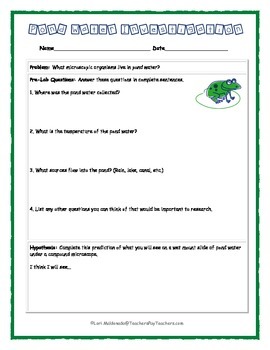




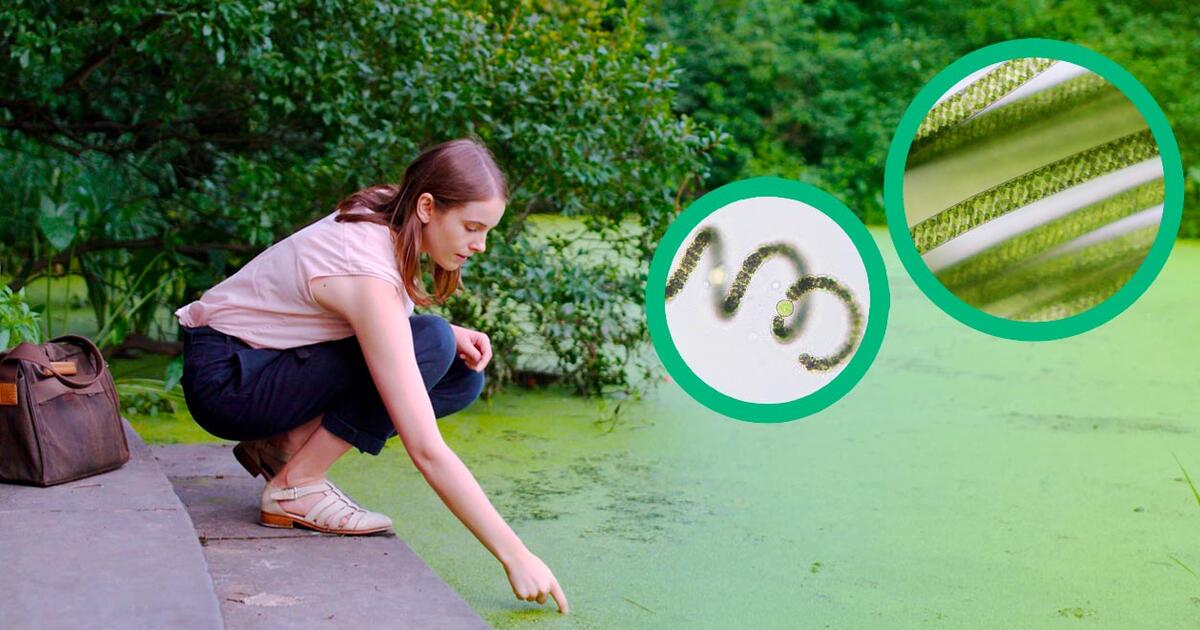


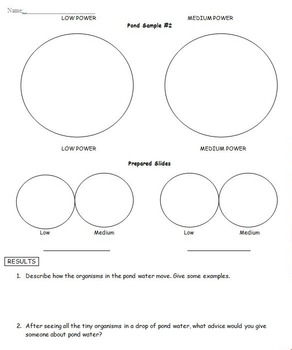



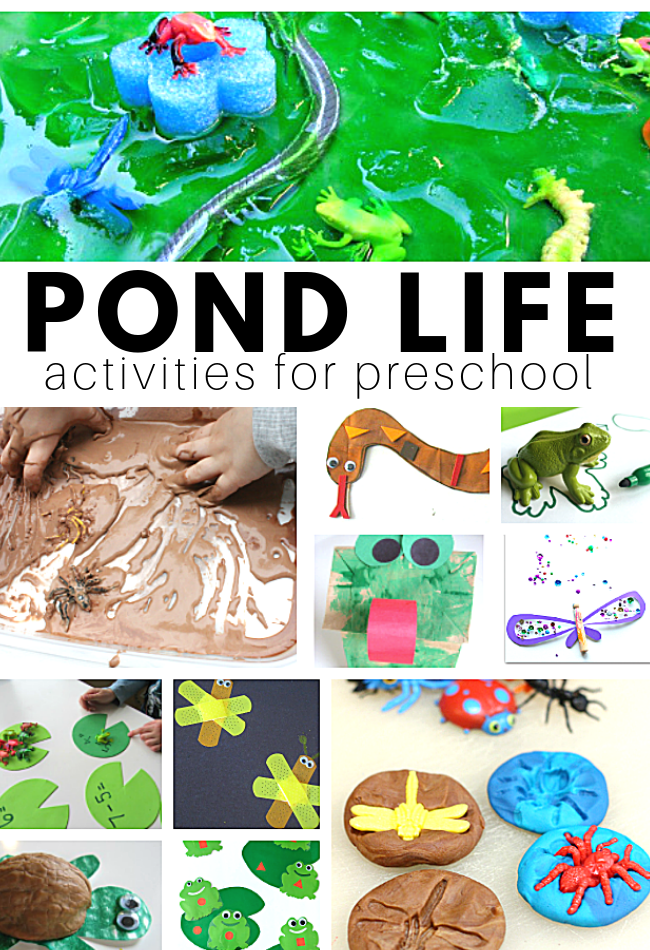
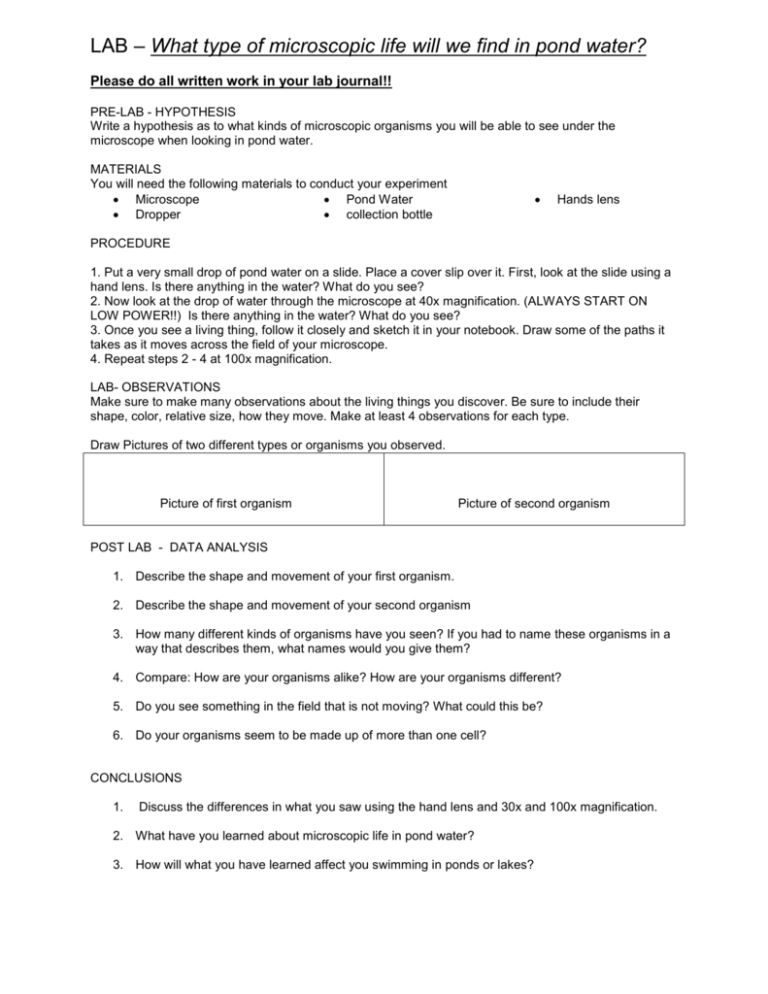











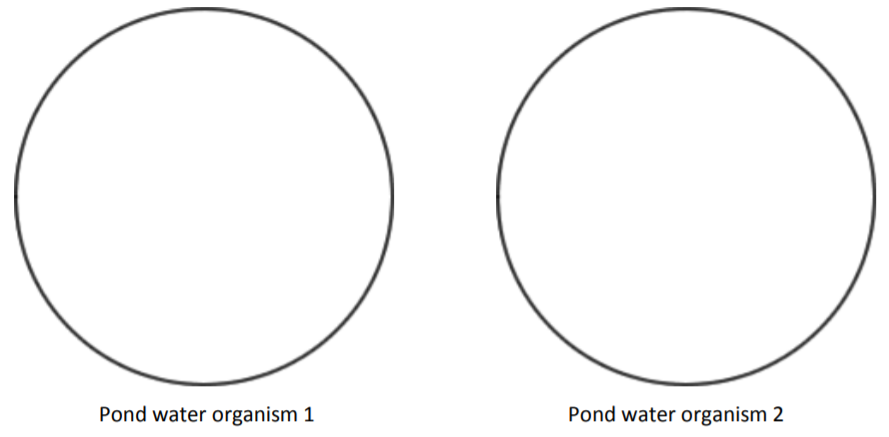


0 Response to "40 pond water lab worksheet"
Post a Comment